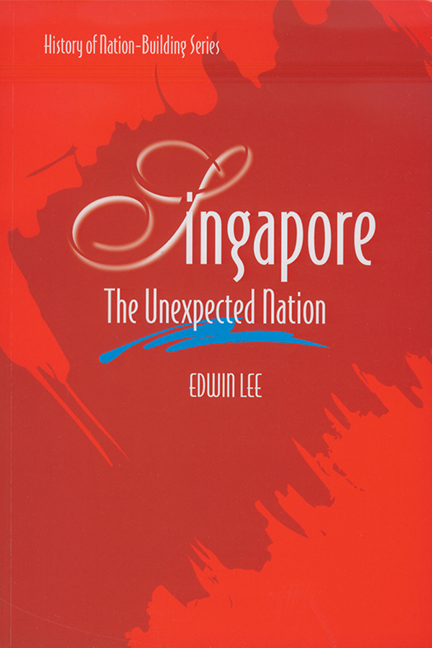Book contents
- Frontmatter
- Dedication
- Contents
- Preface
- Introduction by Wang Gungwu
- Chapter One Beginnings: From Temasek to Singapore
- Chapter Two Race, History and Nationalism
- Chapter Three Contestants and Contesting Visions
- Chapter Four The Accidental Chief Minister
- Chapter Five The Terminal Chief Minister
- Chapter Six The Embattled Prime Minister
- Chapter Seven Merger: Contesting Ownership and Principles
- Chapter Eight Terms of Disendearment
- Chapter Nine Dare to be Equal
- Chapter Ten The Way to Survive
- Chapter Eleven National Service: The Price of Independence
- Chapter Twelve Politics of Education
- Chapter Thirteen Home Ownership, National Stability and the New Middle Classes
- Chapter Fourteen University and Nation
- Chapter Fifteen Toh's Nation-Building Thrust
- Chapter Sixteen Nantah: Between Community and Nation
- Chapter Seventeen Self-Renewal: Talents for a Tough Act
- Chapter Eighteen The Consensual Prime Minister
- Chapter Nineteen Confucianism, Christianity, Chineseness
- Chapter Twenty Singapore Dreams, Singapore Dilemmas
- Chapter Twenty-One The Hyphenated Singaporean
- Chapter Twenty-Two The Unexpected Nation
- Bibliographical Note
- Index
- The Author
Chapter Thirteen - Home Ownership, National Stability and the New Middle Classes
Published online by Cambridge University Press: 21 October 2015
- Frontmatter
- Dedication
- Contents
- Preface
- Introduction by Wang Gungwu
- Chapter One Beginnings: From Temasek to Singapore
- Chapter Two Race, History and Nationalism
- Chapter Three Contestants and Contesting Visions
- Chapter Four The Accidental Chief Minister
- Chapter Five The Terminal Chief Minister
- Chapter Six The Embattled Prime Minister
- Chapter Seven Merger: Contesting Ownership and Principles
- Chapter Eight Terms of Disendearment
- Chapter Nine Dare to be Equal
- Chapter Ten The Way to Survive
- Chapter Eleven National Service: The Price of Independence
- Chapter Twelve Politics of Education
- Chapter Thirteen Home Ownership, National Stability and the New Middle Classes
- Chapter Fourteen University and Nation
- Chapter Fifteen Toh's Nation-Building Thrust
- Chapter Sixteen Nantah: Between Community and Nation
- Chapter Seventeen Self-Renewal: Talents for a Tough Act
- Chapter Eighteen The Consensual Prime Minister
- Chapter Nineteen Confucianism, Christianity, Chineseness
- Chapter Twenty Singapore Dreams, Singapore Dilemmas
- Chapter Twenty-One The Hyphenated Singaporean
- Chapter Twenty-Two The Unexpected Nation
- Bibliographical Note
- Index
- The Author
Summary
One way of approaching the residential districts of the different races and classes of people in Singapore in the colonial era is to note the location of the fresh produce markets. The Orchard Road Market, and next to it, the grocery and frozen meat store, the Cold Storage, and the Grange Road Market in the Tanglin area, served the British ruling elite and the commercial elite, both European and Asian. These elites lived in districts later prosaically numbered 9, 10, and 11, in fine brick and stucco houses with trees, flower beds, lawns, hedgerows, and parks. Nearby were the Botanic Gardens and the University of Malaya/Singapore. The campus was composed of plain arched cloisters enclosing an upper and a lower quadrangle datable to 1929, flanked by buildings of 1950s and 60s origin, the whole dissonant assemblage softened by the leafy landscape around it.
The Asian masses resided in a separate zone, another world altogether, and obtained their daily provisions from one of the great markets in their part of town, namely, the Telok Ayer Market, Maxwell Road Market, People's Park Market, Ellenborough Market, all four in Chinatown, the Clyde Terrace Market in Beach Road, and the Kandang Kerbau Market in the Serangoon area, later depicted as Little India.
Since independence, all but one of these markets, the Maxwell Road one, have disappeared, swallowed by the urge to modernize and redevelop the city state. This is another reason for taking notice of the humble, but landmark-evoking fresh produce markets. It serves as a reminder of how things had changed and progressed, and of how quickly it had all happened after independence.
In what was the first of its kind in Singapore and the region, a shopping mall piled high with multi-storey offices and flats, was built in Singapore between 1970 and 1973. This was the People's Park Complex, erected on the site of the People's Park Market. The Telok Ayer Market, its original function over, is preserved as a national monument on account of its history and ornate wrought iron structure.
The Clyde Terrace Market was absorbed into the site, mostly reclaimed from the sea, of the knife-edged twin towers of I.M Pei, known as the Gateway. The Kandang Kerbau Market too has gone.
- Type
- Chapter
- Information
- SingaporeThe Unexpected Nation, pp. 323 - 358Publisher: ISEAS–Yusof Ishak InstitutePrint publication year: 2008

